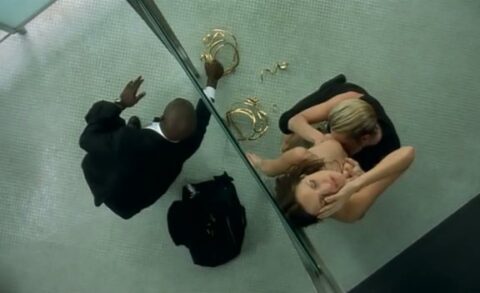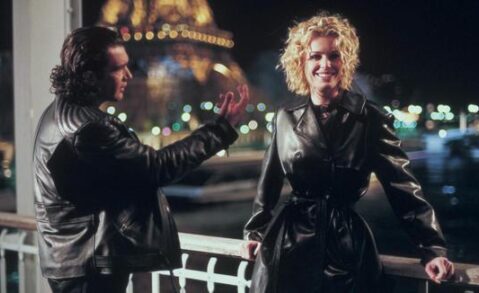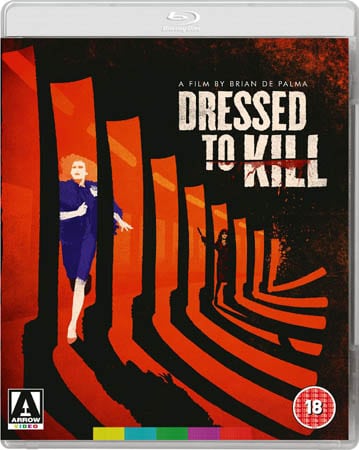Femme Fatale (2002)
Directed by: Brian De Palma
Written by: Brian De Palma
Starring: Antonio Banderas, Eriq Ebouaney, Peter Coyote, Rebecca Romijn
FRANCE/GERMANY/USA
AVAILABLE ON: DVD/BLU-RAY Region A only
RUNNING TIME: 114 mins
REVIEWED BY: Dr Lenera

Mercenary thief Laure Ash is part of a team executing a diamond heist at the Cannes Film Festival, but things go wrong and Laure double-crosses her accomplices, then flees, though she’s photographed by paparazzo Nicolas Bardo. In Paris, she survives being thrown off a high balcony and is taken in by the parents of a missing woman named Lily who looks just like Laure. Then the real Lily returns and commits suicide while Laure secretly watches, but this and a plane ticket that Lily had bought provide Laure with the opportunity to take Lily’s identity for good and start a new life in the United States. However, she eventually finds herself back in Paris and Bardo is still snooping around….

It was only a few months ago, when Femme Fatale was announced as coming out on Blu-ray from Scream Factory on Region A, I realised that this was one Brian De Palma film which I hadn’t seen. How had I overlooked this? Well in any case I then decided to correct that, and, seeing as I’m a physical media guy who can play all regions, order the Blu-ray. De Palma’s starting point seems to have been the idea of the archetypal film noir femme fatale. She’s usually the second lead character, but here De Palma makes her the lead character, and one who’s able to transform into most of the variants of the archetype as well as ensuring that viewers aren’t sure whether they like the person they’re following around for nearly two hours, or even aren’t sure whether they’re supposed like the person they’re following around for nearly two hours. But the writer/director also makes this one of his most personal pictures with the inclusion of the Bardo character, who, like Jack Terry in Blow Out thirty-one years, is something of a stand-in for himself, This must also be one of his most elegant pictures, almost dreamlike the way virtually every single scene is made into a set piece, and especially throughout its first half where there’s very little dialogue, just characters moving gracefully about the sets and the locations. It does push things by having a really coincidence-filled plot which is hard to swallow even by De Palma standards, but then De Palma employs a extremely lazy, overused twist to tie things up, though his filmmaking skills and the concluding material mean that, amazingly, he just about pulls it off.
De Palma’s first script, which some of the cast and crew read, had a different opening to the one that was eventually filmed. There was still a heist, but it took place at a casino where Laure attracts attention by repeatedly winning at a table, after which the seduction, theft and murder follow. But this was a moderately budgeted film and certain things such as the employment of a boat would have stretched finances. Then De Palma recalled when he was at the Cannes Film Festival, arriving on the red carpet accompanied by his girlfriend who was wearing the same outfit that Rie Rasmussen wears in the film, and decided to recreate that. Uma Thurman was originally cast as Laure but cancelled when she became pregnant. De Palma and producer Tarak Ben Ammar then decided to go for a less known face, though Rebecca Romijn was initially reluctant to do the movie due to the amount of sex and nudity the role would require, but eventually changed her mind, hoping that it would do for her what it did for Sharon Stone when she did Basic Instinct. It was Romijn who convinced De Palma that one of her friends, Danish model Rasmussen, would be perfect as Veronica, while Melanie Griffith talked her husband Antonio Banderas into taking the role of Nicolas Bardo, even though it wasn’t the lead, as a favour to De Palma who’d cast her as the lead in Body Double and The Bonfire of the Vanities – though Banderas initially disliked playing a papparazzo as he hated them. Wojciech Kilar was offered a chance to do the music but turned it down. He later regretted the decision after seeing the film. Femme Fatale flopped badly in cinemas and ended up making more money on video. It didn’t even get a cinema release in the UK.
The sounds and then the visuals of Double Indemnity begin the film, a brave device seeing as that’s one of the best film noirs of them all, though it does also immediately tell us what kind of film will be the main influence. No, there isn’t much Alfred Hitchcock here, though when, for example, a character gets off at an isolated highway and waits for the next bus, one can’t help but think of North By Northwest, and I don’t imagine for a moment that De Palma didn’t intend us to think that way. Anyway, the picture of the TV has the reflection of the person in bed who’s watching it, a nice introduction to Laure, though what I found more interesting is that this version of Double Indemnity seemed to have a different music score. Laure’s relaxation is soon interrupted and the sudden opening of a curtain transitions us to the Cannes Film Festival. Laura and company are out to steal some diamonds which are located on a gold ensemble worn by model Veronica, who’s accompanying real-life director Regis Wargnier to the premiere of his film East/West. Now it’s rather unbelievable that this plan would hinge on Laure posing as a photographer and seducing Veronica in order to obtain the diamonds in the toilets, removing bits of her jewellery without her knowing and passing them to “Black Tie” who hands her fakes. However, what with her two accomplices providing support with Racine going down a chute, it makes for a stunning sequence as we cut between several locales set to a variation of Ravel’s “Bolero”, with Laure and Veronica literally steaming up the screen in very erotic fashion even though they never lie down. However, Black Tie has to kill another security guard and is himself wounded, then has to be prevented from shooting Veronica too by Laure.

Laure gets outside with the diamonds and meets an accomplice but is snapped by Barbo, introduced against a background of sex shops. I’m not sure why Bardo is there in the first place, but maybe I’ll work that out on my second viewing. Laure enters a church for some reason and is mistaken for this person called Lily, then returns to a hotel room and has to fight off a killer who would have killed her is she hadn’t landed on some huge rolls of something or other. With the camera and the music score virtually taking over from dialogue as Laure is constantly on the move, this is all hypnotic, seductive stuff, so much so that we can forgive the fact that sometimes it’s not always clear why people are doing what they are, not to mention those awfully convenient things which move the plot forward. Oh look, Lily had bought a plane ticket to America! Lily’s parents actually mistake someone else for their daughter and aren’t freaked out by the resemblance! Laure is soon on the plane, and cosies up to diplomat Bruce Watts whom she’s seated next to after a mix up. She falls asleep on his shoulder and acts perturbed when she awakes with him holding her hand, but this is probably all an act. Cut to seven years later, and Watts is the American Ambassador to France with Laure as his wife. Bardo is now the lowest of the low, posing as a blind old man so he can photograph Laure getting out of a car. Soon her picture is all over Paris, and Laure is very worried that ghosts from her past may find her. Bardo and Laure soon meet in a nicely comic scene well played by Banderas [who’s a tad awkward elsewhere], where Bardo speaks and acts in a rather camp manner as he pretends he’s left a floppy disc in his old hotel room which is now occupied by Laure. Will they get together? Well, this film was made at a time where people still liked to have sex in movies, so what do you think?
What transpires thereafter I won’t reveal in detail, but there’s both real and fake kidnapping, public murders, double crossing and then – then – that bloody twist that was ancient in 1940. As I type I do actually recall, truth be told, a couple of hints strewn earlier in the film which initially seemed either just ridiculous or more weird touches [I’ll say the words “water” and “clocks”], and there were probably more that I missed, so at least you can say that De Palma was playing fair. His sly humour is often ignored, so he puts more of it than usual into Femme Fatale, be it the frequent shots of posters for a film called Deja Vue which not only anticipates some of the story but was the originally intended title for De Palms’s Obsession, to a kidnapping watched by Laure in the much circulated photograph, to Laure’s look of delight at seeing two men fight over her in a fight we don’t even see. There are vicious moments like a nail gun in an eye and a face being smashed several times against a railing, but these are handled with some subtlety, De Palma not being as interested in the red stuff as he used to be, nor is there any more sex after that early sequence until near the end where Romijn has to do a lap dance, which, even though it does serve a purpose [Laure seems to be losing her sexual power over someone so tries to regain it] seems a bit thrown in there and would no doubt invoke the wrath of uptight critics today. De Palma is still interested in things that have fascinated him since the ’70s like double identity, the act of watching and somebody getting a second chance. The camera of Thierry Arbogast [it’s a surprise that De Palma only worked with him once considering his surname] pans and soars all over the place, often binding happenings or locations together, while also providing a great deal of archetypal noir playing with shadows. Split screen comes back, sometimes showing the same twice at the same time with only a slight difference, as does slow motion. That gag of somebody moving to reveal the previously unseen person right behind them, employed in Raising Cain but probably employed first by Dario Argento in Tenebrae, is reused.
There’s the forefronting of a musical score in a way rarely done these days, Ryuichi Sakamoto’s work sometimes even taking the lead, such as when Laure is in Lily’s house and the music describes both her emotions and the action. Bernard Herrmann-like harmonies dominate, though we miss the good melodies that Pino Donaggio and Ennio Morricone used to conjure up for De Palma. Through the course of watching, I couldn’t make up my mind if Rebecca Romijn was entirely good enough for the part. She’s able to present both a cold erotic appeal and a deep vulnerability, but not always that they seem like two facets of the same character. But then De Palma wrote her more as a symbol than a fully fledged character, and she’s consciously being asked to evoke different femme fatales of cinema history, though it’s possible to forget this when the final act seems to be more about fate, the potential pathways which our lives can go down [and this isn’t revealing much]. Of course there’s also the character of Bardo who ends up completing his masterpiece, a collage of photographs that’s much like a movie in that it consists of various elements shot at different times assembled into something that’s coherent. De Palma seems more positive about the nature and importance of cinema than he did in 1981, where it seemed pointless in a world of deceit and control, which is ironic considering Femme Fatale‘s fate, not to mention that we currently live in a stifling cinematic climate where filmmakers like De Palma are fully needed but probably wouldn’t be able to flourish to any great degree. But there’s no doubt in my mind that, after finally having seen it, it’s his last major, fully realised statement on film; the four films he’s made since then all have marvelous elements to varying degrees but feel restricted and don’t really “get there”. Even if it sometimes baffles and even frustrates, or dare I say partly because it sometimes baffles and even frustrates, Femme Fatale is De Palma often firing on all cylinders.
Rating: 









A curious fact about Scream Factory’s Blu-ray is that, although some of the French dialogue is not subtitled, if you switch on the English subtitles more of it, though certainly not all, is translated. This could be another joke, in a film where one scene has the subtitles supply standard thriller dialogue yet the lips of the people supposedly speaking it aren’t moving.





Be the first to comment